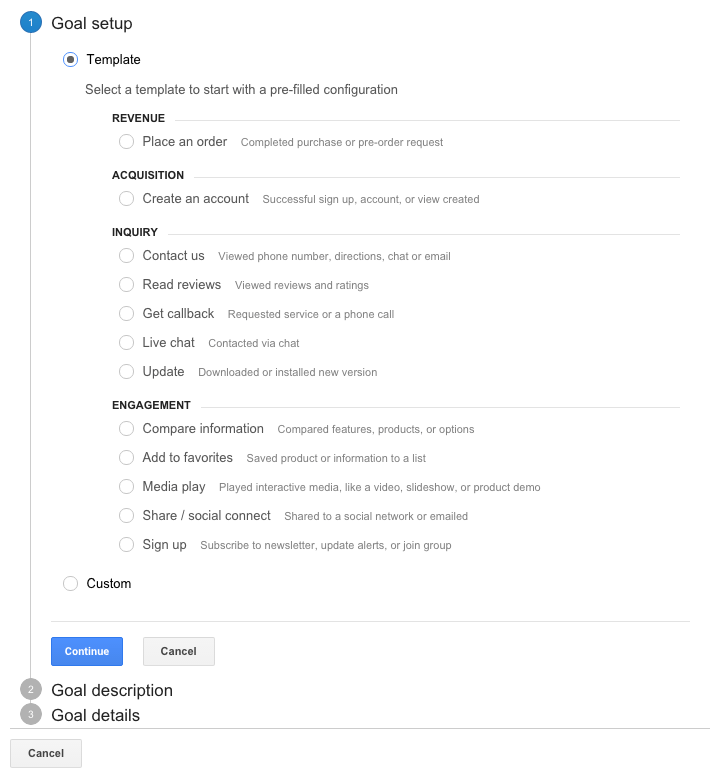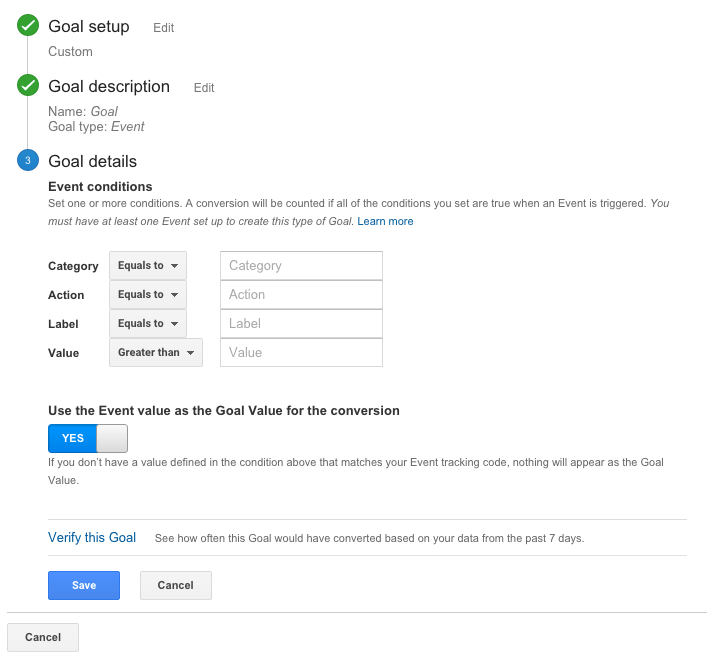Goals are one of the most important parts of Google Analytics and unfortunately, one of the most underutilized. Goals define the most important business objectives (KPIs) for your website. You can then use these KPIs to determine the value of your online marketing campaigns, measure the success of your content marketing, and determine the general effectiveness of your website.
You can quickly set up goals for your website in Google Analytics in three steps. To begin, open the Administration page of your Google Analytics account, and click on “Goals” under the View where you want to create goals. Then click “+New Goal” to create a goal.

Step 1: Goal Setup
When you set up a new goal, you can define a custom goal or choose one of Google Analytics’ pre-configured templates, which are suggestions of some typical goals for your website’s Industry Category. These templates might include goals like “Create an account” or “Contact us”. If you do not see any templates in your Google Analytics interface, select an Industry Category in your property settings then return to Goal setup.
We recommend that you use goal templates to begin setting up goals for typical business objectives. You can then use custom goals for your individual business objectives.

Step 2: Goal Description
In the Goal description step you must provide the goal with a name, goal ID and type.
- The name should be a short descriptive name that will be easily understandable to all users of the Google Analytics View.
- An available “Goal slot ID” will be automatically pre-selected. It is not recommended to change this pre-selected ID unless you have a precise reason.
-
For goal type you can select:
- Destination: if the goal is a specific page destination, for example, the confirmation or thank-you page after a transaction
- Duration: if the goal is that a session lasts a certain amount of time or more
- Pages/Screens per session: if the goal is a certain number of pageviews or more (screens in the case of mobile apps)
- Event: if the goal is an action that is tracked as an event on your website
Step 3: Goal Details
In this final step you need to define a specific page, amount of time, number of pages, or event, depending on the goal type you selected in the previous step. The details are different for each type. For example, the details for a destination-type goal include:
- Destination: Define a way to match the URL of the destination page using either “Equals to” to exactly match, “Begins with” to find all pages that start with an expression, or “Regular expression” to create more complex matching.
- Funnel: Specify the steps along the path that users take to the goal. Set the “Required?” field to “NO” if there are different paths that users can take. We recommend this optional step because it creates useful funnel visualizations in Google Analytics’ Conversion Reports. See Google Analytics Support for more information.

A Note about Goal Value:
We recommend setting a value also for all non-ecommerce goals, so that you can easily identify which goals are more important than others. You should set up goals for micro-conversions like newsletter subscriptions as well as for macro-conversions like new leads. The value that you set for each goal should reflect how important it is to your primary business objectives.
The value of ecommerce goals should be captured by ecommerce tracking, and you should not set a goal value in the goal setup in Google Analytics.
Good to Know:
- You can create up to 20 goals in each Google Analytics View.
- It is not recommended to significantly change goal details or type once a goal has begun recording, since this will create confusion in reports.
- You can share goals between different Google Analytics accounts by using the “Share Assets” feature.
Do you need help understanding what goals you can and should create for your website? Send me an email, I am happy to help!









